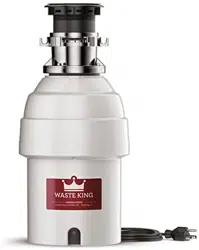Documents: Go to download!
User Manual
- User Manual - (English, French, Spanish)
- User Guide - (English)
- Product Documentation - (English)
- Specification Sheet - (English)
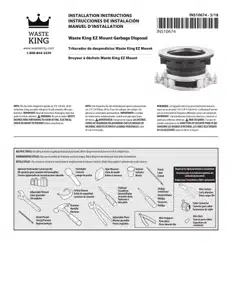
- Tools and materials you may need
- REMOVAL OF OLD UNIT
- DISHWASHER CONNECTION
- INSTALLATION OF MOUNTING ASSEMBLY
- ELECTRICAL CONNECTIONS
- ATTACHING DISCHARGE ELBOW
- CONNECTING DISPOSER TO MOUNT ASSEMBLY
- OPERATING INSTRUCTIONS
- TROUBLESHOOTING
- CLEANING AND MAINTENANCE
Table of contents
USER MANUAL FOOD WASTE DISPOSER
Tools and materials you may need

REMOVAL OF OLD UNIT
TYPICAL INSTRUCTIONS, YOUR MODEL MAY VARY.
Before starting this step, turn off electrical power at the circuit breaker or fuse box.
If your old mount is the same as the mount on your new disposer, just reverse the assembly instructions found in section 3. If your new mount system is different, follow these instructions:
A. Use a pipe wrench to disconnect drain line where it attaches to disposer discharge tube (see 1A).
B. Remove disposer from sink flange by turning mount ring to the left clockwise (see 1B). If you are unable to turn the mount ring, tap on one of the extensions from the ring with a hammer. Some mounting systems have tubular extensions. Inserting a screwdriver into one tube will provide additional leverage for turning the mount ring (see 1B). Some disposers may require the removal or loosening of nuts from the mount screws (see 1C). Some disposers may require the removal of a clamp.
Caution: Be sure to support the disposer while performing this step or it may fall when the mounting ring is disconnected from the mounting assembly. If your disposer is hard wired (metal shielded cable not utilizing a wall plug), complete steps C and D. If you utilize a plugin cord, go on to step E.
C. When disposer is removed, turn up side down and remove electrical cover plate (see 1D).
D. Use screwdriver to remove green ground wire. Remove wire nuts from black and white power wires and separate disposer wires from power cable wires. Loosen screws on cable clamp and separate cable from disposer.
E. To remove remaining mount system from the sink, loosen mount screws, push mount ring up. Under it is the snap ring. Use screwdriver to pop off ring (see 1E). Remove mount ring, protector ring and gasket from sink flange. Some mounts will require the unscrewing of a large ring holding the sink flange in place. Pull sink flange up through sink and clean off old putty from sink.
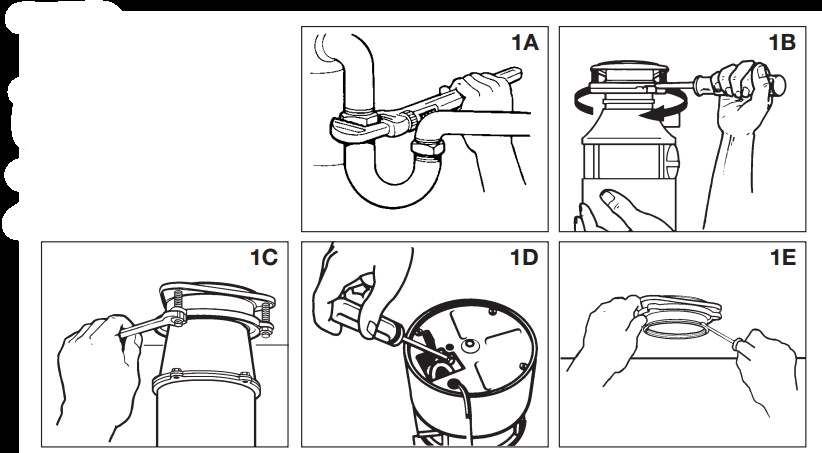
DISHWASHER CONNECTION
If you are utilizing a dishwasher, complete the following procedure. If dishwasher is not to be connected go on to section 3.
A. Using a blunt instrument (steel punch or wooden dowel), knock out entire plug (see 2A). Do not use a screwdriver or sharp instrument. When knockout plug falls into disposer, you may remove it or simply grind it up when the disposer is used. This will not damage the disposer in any way, but may take some time to grind, over the course of several uses. Go to Section 3.
B. Connect dishwasher hose using hose clamp. If hose size is different, you will need a Dishwasher Connector Kit (see 2B). Make sure all plumbing connections are tight and in accordance with all plumbing codes and ordinances. Run water and check for leaks.
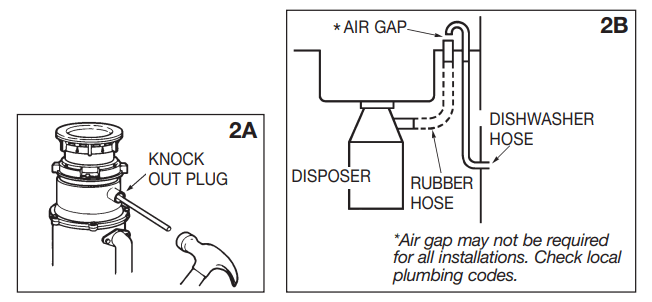
INSTALLATION OF MOUNTING ASSEMBLY
YOUR DISPOSER COMES WITH ONE OF THE FOLLOWING MOUNT SYSTEMS
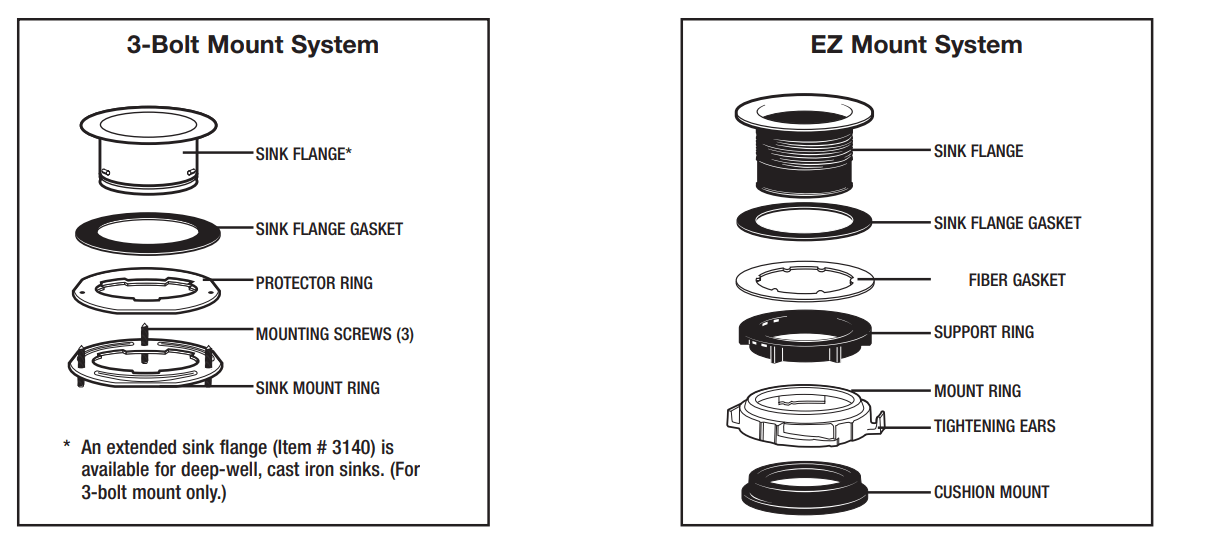
Proceed to the instructions for your type of mount system.
3-Bolt Mount System
READ COMPLETELY BEFORE STARTING
NOTE: Pay close attention to the order of mount assembly parts, as they have been correctly assembled by the factory. (See 3A and 3B.)
A. Disassemble the mounting assembly, as it has been shipped, by turning the sink flange until the projections align with the notches in the mount ring and allow you to pull the sink flange up and out of the remaining mount assembly. Note the sequence of these parts as they are stacked and refer to 3A and 3B to identify each part. Unpack the 3 mount screws and screw them half way through the mount ring (notice “THIS SIDE UP” is imprinted on top of the mount ring). Next, stack the rubber gasket on top of the protector ring and sit them on top of the pointed ends of the mount screws.
B. Keep these assembled parts together and set aside. Before you connect the disposer to the mount assembly under the sink, you may want to practice engaging the groove of the Hush Cushion® to the ridge at the bottom of the sink flange (see 3A and read Sec. 6).
C. Be sure your sink is clean. Pack the underside rim of the sink flange with plumber’s putty (see 3C). Position the sink flange so it is centered and readable as you look into your sink. Push the sink flange firmly into the sink opening to make a good seal. DO NOT move or rotate the sink flange once seated or the seal may be broken.
D. Take the remaining portion of the mount assembly, as it was set aside and make sure that the rubber gasket is on top of the protector ring. From under the sink, while holding the sink flange firmly with one hand, line up the notches in the mount ring with the projections of the sink flange. Slide the mount assembly up onto the sink flange, past the projections and give the mount assembly a 1/4 turn, so that it will hang by itself (see 3D).
E. Tighten the 3 mounting screws evenly with a screwdriver (see 3E). DO NOT OVERTIGHTEN! Trim off excess putty.
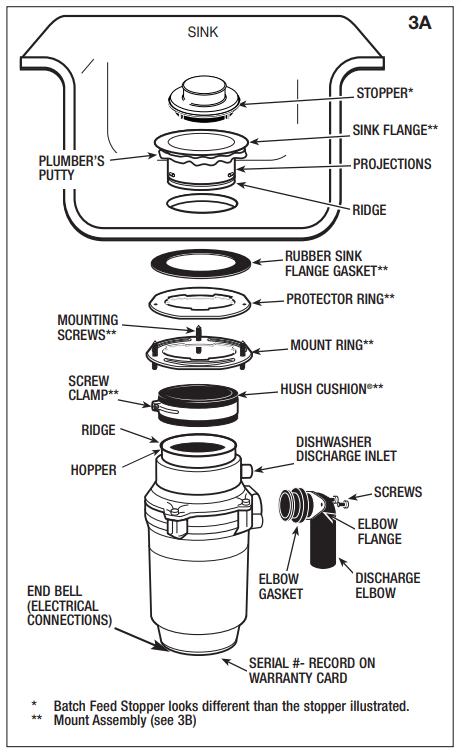
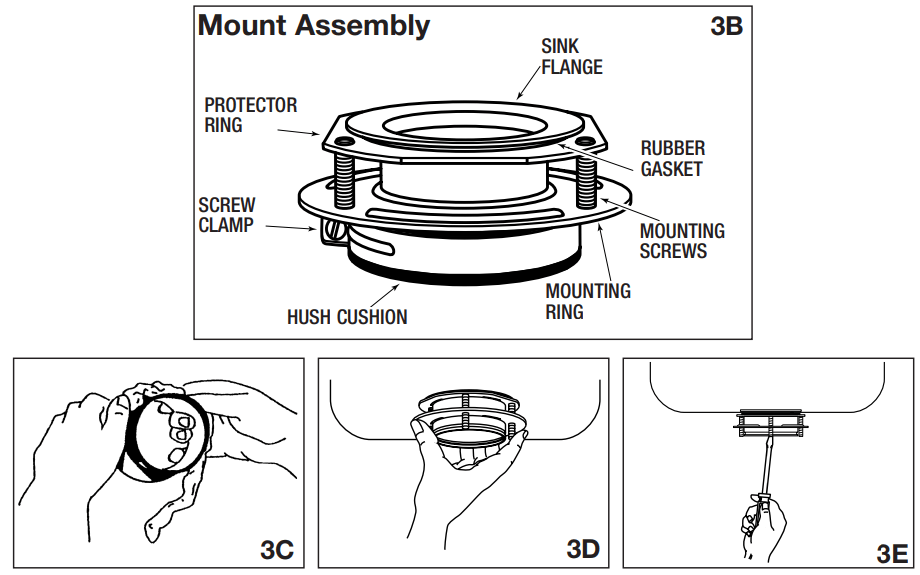
EZ Mount System
READ COMPLETELY BEFORE STARTING
NOTE: Pay close attention to the order of mount assembly parts, as they have been correctly assembled by the factory. Also, reference the cushion mount detail in illustration 3J below for the proper orientation of the cushion mount.
NOTE: Try practicing this assembly before you get under the sink to get the “feel” of how the parts fit together.
A. Disassemble mount assembly from disposer by turning mount ring to the left (clockwise) and remove.
B. Raise mount ring toward top of sink flange. Remove cushion mount. Remove mount ring. You may want to practice installing the cushion mount at this point before you are under the sink. See paragraph H. Also see the “Important Notice: Cushion Mount Detail.”
C. Unscrew support ring from sink flange and remove fiber gasket. You are now left with sink flange and rubber gasket.
D. The rubber gasket is used instead of plumbers putty with stainless steel sinks. Other sinks will require putty.
E. If no putty is used, insert sink flange through rubber gasket into sink opening. Do not rotate sink flange once it is seated.
F. If you use putty instead of the gasket, form a ring around underside of sink flange. Insert flange into sink opening, press down hard to squeeze out excess putty. From under sink, trim off excess putty flush with bottom edge of sink opening.
G. From underneath sink, slip fiber gasket onto exposed sink flange. With arrows pointing up, screw support ring onto the sink flange, hand tighten until the sink flange will not move (see 3F). At this point you may want to insert stopper in sink and fill with water to check sink flange seal and insure there are no leaks.
H. Place mount ring over sink flange and hold in place while installing cushion mount (large side down) so the groove on the inside of cushion mount fits over lip on sink flange, similar to putting the lid on a plastic container (see 3G, 3H & 3J). Please read important notice below.
IMPORTANT NOTICE: CUSHION MOUNT DETAIL
When the cushion mount is installed correctly, the lip of the sink flange fits into the groove on the inside of the cushion mount and mount ring can be pulled downward over cushion mount and will be free to rotate. The bottom bead of the cushion mount acts as a gasket between the bottom of the sink flange and the top of the disposer. See illustration 3J.


ELECTRICAL CONNECTIONS
A. Connect disposer to 110-120 Volt, 60 Hz AC current only.
B. If plug-in cord is used, use a three prong plug (see 4A). Ground wire should be attached to the ground screw in the bottom of the end bell (see 4B).
C. Use a cable clamp strain relief connector where power cord enters the disposer (see 4C).

Wiring Disposer Directly to House Current
This appliance must be connected to a grounded, metal permanent wiring system or an equipmentgrounding conductor must be run with the circuit conductors and connected to the equipment-grounding terminator or lead on the appliance.
A. If you use BX cable:
1. Install cable connector in hole.
2. Connect white wire to white lead of disposer.
3. Connect black.
4. Connect bare ground.
If BX cable is not used, provide a separate ground wire to nearest cold water metal pipe or other suitable ground, using the screw in the bottom of the end bell for the ground wire (see 4C).
B. If your power supply does not include a ground wire, you must provide one unless metal cable is used. Attach a copper wire securely to disposer ground screw and attach other end of wire to a metal cold water pipe. Use only UL approved ground clamp. If plastic pipe is used in your home, a qualified electrician should install a proper ground.
ATTACHING DISCHARGE ELBOW
A. Connect waste elbow to the disposer (see 5A), proceed to step 6 and then connect bottom of the elbow by tightening the slip nut (see 5B). B. If you are connecting to a dishwasher, return to section 2B. If not, make sure all plumbing connections are tight and in accordance with all plumbing codes and ordinances. Run water and check for leaks. | 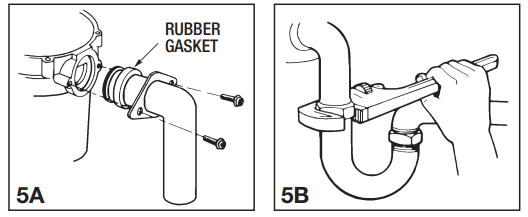 |
CONNECTING DISPOSER TO MOUNT ASSEMBLY
3-BOLT MOUNT (See section 3 for your mount type.)
A. Press firmly around the Hush Cushion® to ensure it is engaged with the neck of the disposer.
B. Lubricate the top inside lip of the rubber Hush Cushion® with a liquid soap.
C. Line up discharge elbow of disposer with trap under mounting assembly. Guide disposer up and engage the groove of the Hush Cushion® around the ridge at the bottom of the sink flange (see 6A & refer back to 3B). While still supporting the disposer, tighten the screw-clamp around Hush Cushion®. The disposer will now hang by itself.
D. If you need to turn the disposer make sure the sink flange does not turn. It will break the seal created when installed. Go back to steps 5A and 5B.
Lubricate top angled surface of rubber Hush Cushion® with liquid soap prior to engaging disposer to sink flange. Fit Hush Cushion® lip into sink flange groove using a slight rocking motion. Tighten clamp (see 6B).
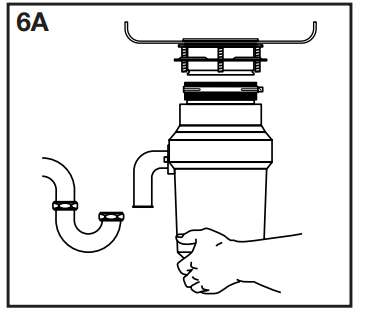
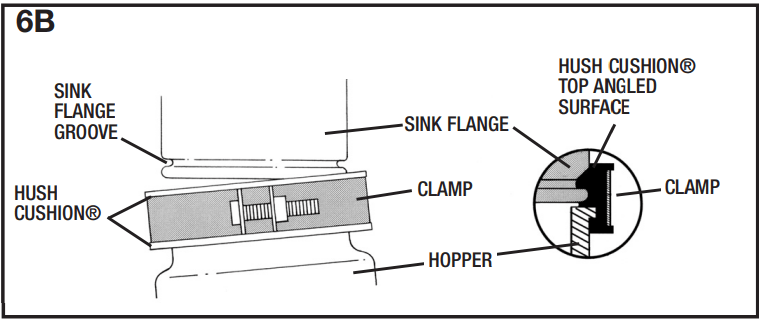
EZ MOUNT (See section 3 for your mount type.)
A. Line up disposer under mounting assembly. Guide hopper projections into mount ring slots. Turn mount ring about 1/4” to right so that disposer is temporarily supported (see 6C).
B. Turn mount ring and disposer until disposer elbow lines up with trap (see 6D).
C. Turn mount ring to the right (counter-clockwise) until it locks up tight. Tap the mount ring ears with a hammer until the lock position is achieved. Hopper projections must be to extreme left of mounting slots (see 6E).
D. If mount ring is hard to turn, you may add a small amount of petroleum jelly or liquid soap to hopper projections. Run water and check for leaks.


OPERATING INSTRUCTIONS
The Anti-Jam Swivel Impellers make a clicking sound as they swing into place. This indicates normal operation.
A. Remove sink stopper. Turn on a medium flow of cold water.
B. Turn switch to ON position; your motor is turning at full speed and ready to use.
C. Scrape in food waste. Down the drain go table scraps, peelings, rinds, seeds, pits, small bones and coffee grounds. To speed up food waste disposal, cut or break up large bones, rinds and cobs. Large bones and fibrous husks require considerable grinding time and are more easily thrown away with other trash. Do not be alarmed that the disposer slows down while grinding. The disposer is actually increasing torque (grinding power) and is operating under normal conditions.
D. Before turning disposer off, let water and disposer run for approximately 15 seconds after shredding stops. This assures that all waste is thoroughly flushed through trap and drain.
E. It is not recommended to use hot water while running disposer. Cold water will keep waste and fats solid so disposer can flush away particles.
TIPS FOR SUCCESSFUL OPERATION
A. Be sure disposer is empty before using your dishwasher so it may drain properly.
B. You may want to leave the stopper in the drain when not in use to prevent utensils and foreign objects from falling into the disposer.
C. Your disposer is ruggedly built to give you many years of trouble free service. It will handle all normal food wastes, but it will NOT grind or dispose of such items as plastic, tin cans, bottle caps, glass, china, leather, cloth, rubber, string, clam and oyster shells, aluminum foil or feathers.
BATCH FEED OPERATING INSTRUCTIONS
The Anti-Jam Swivel Impellers make a clicking sound as they swing into place. This indicates normal operation. A. Remove sink stopper and turn on a medium flow of cold water. B. Scrape in food waste. Down the drain go table scraps, vegetable peelings, cobs, rinds, pits, bones and coffee grounds. (see 7A) C. Insert stopper to start disposer. (see 7B) One of the two small slots in stopper base must line up with switch plunger inside the neck of the disposer. Push down firmly to turn the disposer on. Lift stopper to shut the disposer off. D. Run disposer for 15 seconds after shredding stops. This assures that all waste is thoroughly flushed through the drain. E. To fill sink, insert stopper and align the largest slot with the switch plunger. (see 7C) Push down to seal sink without starting the disposer. When medium sized slot (see 7B) in stopper base is lined up with the switch plunger, water can drain, but tableware, etc., cannot be accidentally dropped into disposer. | 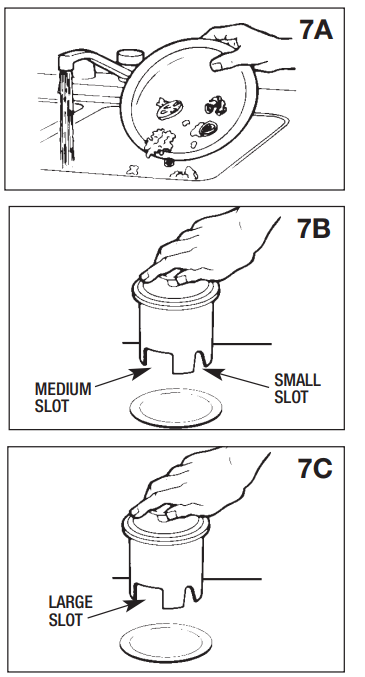 |
TROUBLESHOOTING
Before seeking repair or replacement, we recommend that you review the following:
LOUD NOISES: (Other than those during grinding of small bones and fruit pits): These are usually caused by accidental entry of a spoon, bottle cap or other foreign object. To correct this, turn off electrical switch and water. After disposer has stopped, remove *splash guard, remove object with long handled tongs, and replace *splash guard.
UNIT DOES NOT START: Unplug power cord or turn either the wall switch or breaker box switch to “OFF” position, depending on your model and wiring configuration. Remove stopper and/or *splash guard. Check to see if turntable will rotate freely using a wooden broom handle. If turntable rotates freely, replace *splash guard and check re-set button to see if it has been tripped. Re-set button is red and located opposite discharge elbow, near the bottom (see 8A). Push button in until it clicks and remains depressed.
If re-set button has not been tripped, check for shorted or broken wire connecting to disposer. Check electrical power switch, fuse box or circuit breaker. If wiring and electrical components are intact, the unit may have internal problems that require service or replacement.
* Splash guard not used on Top Control/Batch Feed unit.
IF TURNTABLE DOES NOT ROTATE FREELY: Turn off disposer, then check for any foreign object lodged between the turntable and grind ring. Dislodge object by rotating table with a wooden broom handle and remove object. (see 8B) If no foreign object is present, there may be internal problems.
LEAKS: If the unit leaks at the top, it may be due to:
- Improper seating of sink flange (gasket centering, putty or tightening).
- Support ring not tightened properly.
- Defective or improperly installed cushion mount.
If unit leaks at the waste elbow, leak may be due to improper tightening of elbow flange screws.
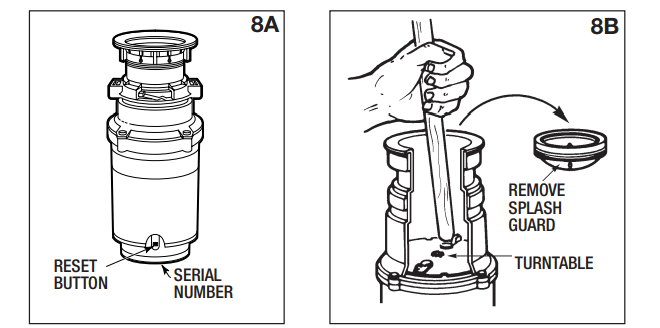
CLEANING AND MAINTENANCE
DO NOT ATTEMPT TO LUBRICATE YOUR DISPOSER!
The motor is permanently lubricated. The disposer is self cleaning and scours its internal parts with each use.
NEVER put lye or chemical drain cleaners into the disposer, as they cause serious corrosion of metal parts. If used, resulting damage can be easily detected and all warranties are void. Mineral deposits from your water can form on the stainless steel turntable, giving the appearance of rust. DO NOT BE ALARMED, the stainless steel turntables used will not corrode.
See other models: L-111 L-3200 L-2600 L-8000 L-1001
